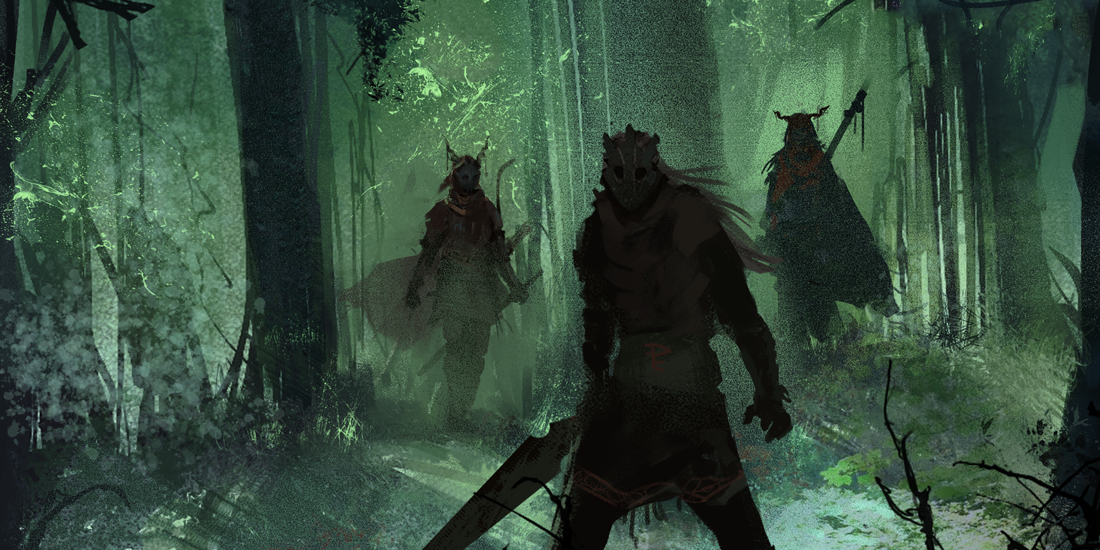Abominations, and the Curse of Blight
This is a mechanical adaptation of
The Curse of Blight
In Ravengrin, magic is dangerous. Just being in proximity to places touched by the arcane can expose you to the corrupting presence of Blight, let alone directly wielding its power. And yet, in its unpredictable volatility, Blight can fuel even more miraculous works of magic, can lead to unspeakable power ... power which comes at an equally unspeakable price. Blight manifests itself mechanically in game, as numerical quantities which you as a player must keep track of. Blight comes in two forms: temporary or permanent, and builds over time. As a player, you should keep track of these two numbers separately, as well as their sum, your total Blight. Temporary Blight is rampant throughout Ravengrin, streaming off of magical artifacts, infecting arcane ruins, and flowing directly from spells. Temporary Blight disappears after completing a long rest, but for every 10 temporary Blight you accrue between rests, you gain 1d4 permanent Blight. Permanent Blight is far less prevalent than temporary Blight, being a slow buildup of corruption from long exposure to Blight. Exposure to large amounts of Blight, or being struck by Abominations, can cause you to build up permanent Blight.Threshold
Blight introduces a new statistic to your character: Threshold. A character’s Threshold equals to twice their proficiency bonus + their spellcasting ability modifier. Characters without a spellcasting ability use a different ability score, as determined by their class. Closely tied to the creature's willpower and resolve, Threshold represents how much Blight a creature is able to withstand. Threshold naturally increases as a player levels up, scaling with their proficiency and ability score, but it can also be increased through significant roleplaying moments, at the DM's discretion. If a character's total Blight (temporary Blight + permanent Blight) ever equals or exceeds their Threshold, they have reached the limit of how much magical corruption they can withstand. After this, any Blight they gain is permanent. In addition, they gain one Stain. If a creature's Permanent Blight equals or exceeds their Threshold, the character risks becoming a Blight-infested horror, permanently transformed and mutated into a savage, violent creature: an Abomination. When this happens, the creature must succeed a Charisma, Wisdom, or Constitution saving throw (their choice) whose DC equals their Threshold. If they succeed, they resist the effect of the transformation. However, being exposed to additional Blight after this triggers another saving throw. For every saving throw succeeded, they gain one Stain. If a creature successfully resists the effects of the transformation, once removed from direct Blight exposure, their Threshold increases by an amount equal to twice the number of times they resisted the transformation.Pushing Your Threshold
Exceeding your Threshold comes at a great cost, but with an equally great reward. When you cast a spell while over your Threshold, the spell acts as though it were cast at one spell slot higher. In addition, spells that deal damage also inflict permanent Blight on their target equal to the spell's level. Melee and ranged attacks made while pushing your Threshold inflict an additional amount of damage equal to the creature's level. In addition, the creature can choose, at the expense of gaining an additional 1d10 permanent Blight, to gain advantage on any melee or ranged attack role.Stains
The journey into Abomination is not sudden. It manifests itself, in a creature's mind and body. As the creature grows nearer and nearer to Abomination, these manifestations grow more and more severe. These affects are known as Stains. You gain Stains by exceeding your Threshold, as well as through other, more specific means.Reducing Permanent Blight and Stains
Blight is an infection, a blotch, a blemish. It is not easily lost. However, Each time a creature takes a long rest, they may make a Charisma, Wisdom, or Constitution saving throw (their choice) equal to their Threshold + 2d4. On a success, their Permanent Blight is reduced by 1. On a critical success, it is reduced by an amount equal to their proficiency bonus. If a creature fails this saving throw while pushing their Threshold or after resisting the effects of an Abomination Transformation, they gain a Stain.Means of Exposure
Certain things in Ravengrin expose a character to Blight.Magical Places
Throughout an adventurer's, grave robber's, or explorer's career - which are often short, and violent in their ending - it is not uncommon to come across places touched by the presence of magic. In Ravengrin's wild lands, ancient ruins from before the times of the humans, places where the veil between this reality and that of the arcane are thin. In these places, magical power - and Blight - lie heavily. Just being near these places expose a creature to Blight, though, admittedly, not as much as other sources. DM discretion is advised, but a table is provided for quick reference.Artifacts
Any time you use a magic item, roll a d20. On a Natural 1, you accrue Blight according to the items rarity.Spellcasting
Casting spells is the easiest way to expose yourself to Blight. When you do so, you accrue temporary Blight equal to the spell's Blight level. However, different traditions of spellcasting have increased - or decreased - resistance to Blight's infection. Wizards, who do not directly wield the power of magic, are not as heavily affected by it. Because they do not cast spells spontaneously, through their own power, but instead spend hours carefully practicing each spell, they only gain half the Blight from casting spells, rounded down. Those who practice Nature magic have the greatest resistance to Blight. Sorcerers, those who walk closest to the corrupting power of magic, have no resistance of the affects of Blight. However, able to harnest the most raw form of spellcasting, when pushing their Threshold, Sorcerer spells as treated as two slots higher, instead of one.Abominations
Remove these ads. Join the Worldbuilders Guild









Comments